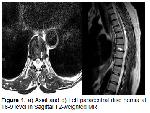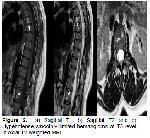In this study, it was observed that musculoskeletal system pathologies were quite common in patients who applied to the surgery outpatient clinic with the complaint of breast pain and did not have breast pathology. Pain caused by adjacent musculoskeletal structures was frequently detected in patients with mastalgia. We think that younger patients with mastalgia should be investigated for FMS and MFPS, and older patients for vertebral disc pathologies.
One of the chronic pain syndromes, FMS is considered as a rheumatological disease that negatively affects quality of life and causes social problems especially in women, and it is one of the central sensitivity syndromes 7. In a survey study investigating the comorbidity of mastalgia and chronic pain syndromes, patients with mastalgia were questioned for fibromyalgia, irritable bowel syndrome and chronic pelvic pain in the last 1 year, and a strong correlation was found between mastalgia frequency and FMS, chronic pelvic pain and irritable bowel syndrome 14.
Sen et al. showed that the comorbidity of FMS and mastalgia was more frequent than expected, furthermore mastalgia was detected in approximately half of the patients (47.2%) with FMS at the time of admission. On the other hand, 37.7% of patients with mastalgia met the diagnostic criteria for fibromyalgia syndrome 7. The authors stated that mastalgia may also be a part of central sensitivity syndromes and may even be included in FMS criteria 7.
In Turkey, Genc et al. 15 investigated the comorbidity of fibromyalgia and mastalgia by evaluating mastalgia prevalence in patients with fibromyalgia and vice versa in their study that included 50 patients with mastalgia and 50 patients with fibromyalgia. While 36% of patients with mastalgia met the criteria of fibromyalgia, mastalgia was detected in 42% of the patients in the fibromyalgia group. In the present study, FMS was diagnosed in 75% of patients with mastalgia, and this rate was higher than other studies. The reasons for this can be the inclusion of patients with moderate pain (VAS 5-6) into the study and the limited number of cases. FMS is mostly seen in women between the ages of 30-60. Although not statistically significant, patients with FMS in this study constituted the younger patient group, which is consistent with the literature data 16.
MFPS is a musculoskeletal system disease that presents with symptoms and signs such as pain, muscle spasm, sensitivity, mobility restriction, weakness and rarely autonomic dysfunction in one or more muscles and/or connective tissue and characterized with hypersensitive points called trigger points. Symptoms are usually felt in areas away from the trigger point 16,17. The distribution of the trigger points varies among individuals. In one study, 214 women and 103 men with MFPS were examined and it was shown that more trigger points were present in the head, neck, shoulder girdle, and waist compared to other parts of the body. Pain reflected from the trigger point is felt more severely in the neck and shoulder girdle compared to other regions 16,18. Specific myofascial pain syndromes cause subacute and chronic pain like FMS. Tenderness, trigger points, and symptoms such as muscle spasm develop gradually. With respect to the thorax, pectoralis major syndrome, serratus anterior syndrome, sternalis syndrome, and precordial catch syndrome are among the pains in this group. According to the literature, MFPS is seen between the ages of 30-49 19-21. There are no studies in the literature investigating myofacial pain in patients with mastalgia, but there are studies on MFS in patients who have undergone surgery due to breast cancer. In a study on 116 patients conducted by Lacomba et al., MFS was identified as a potential and frequent cause of chronic pain in patients who completed 1 year follow-up after breast surgery and axillary lymph node dissection. The rate of MFS was 44.8% in this patient group 22. In the present study, the number of patients with mastalgia also diagnosed with MFPS was 22 (40.7%). This has been defined for the first time in the literature and the current study also demonstrates that MFAS can show high level of comorbidity with mastalgia, especially in younger patients.
Among the pathologies originating from the thoracic wall, costochondritis (Tietze syndrome) is closely associated with mastalgia. In a 1976 study, Preece et al. examined 232 patients presenting with breast pain and diagnosed Tietze syndrome in 25 (10.8%) of these patients. These patients were 13-62 years old and the mean age was 35. The patients reported that their pain was localized in the chest wall rather than the breast and to the medial side. In another study, Tietze syndrome was diagnosed in 17 (6.7%) of 258 mastalgia patients 23,24 In accordance with the literature, 6 (11%) patients were diagnosed with costochondritis in the present study. The relationship between mastalgia and Trietze syndrome has not been reassessed for many years in the literature. Despite the rapid developments in technology and accordingly, in treatment modalities, the diagnosis of costochondritis can still be made by examination and the present study has shown that the rate of detection of costochondritis in patients with mastalgia has not changed.
Pain complaints due to vertebral degeneration are common in the overall population and this rate increases with age. In MRI, the decrease in intervertebral disc signal intensity is observed in 17% of males and 12% of females between the ages of 20-29 and 86% of males and 89% of females between the ages of 60-69 25. Pirti et al. 26 performed MRI examination on 100 patients with mastalgia and detected no pathology in only 4 (4%) patients, diffuse annular bulging in 49 (49%) patients, cervical vertebrae and cervical disc protrusion in 47 (47%) patients, and thoracic disc protrusion in 12 (12%) patients. Among these 12 patients, 7 had cervical diffuse annular bulging and 5 had cervical disc protrusion. In the present study, the number of patients with degenerative disease in any of the cervical discs revealed by MRI was 31 (59.3%). The number of patients with degenerative disease associated with thoracic discs was 14 (23.3%). MRI evaluation revealed cystic neoplasia in cervical syrinx in 1 (2%) patient, thoracic spondylosis in 1 (2%) patient, and T4 hemangioma in 1 (2%) patient. These rates show that coexistence of vertebral pathologies is quite high in patients with mastalgia. The fact that patients without cervical disc hernias were younger is also consistent with the literature, and it is stated in the literature that the prevalence of disc degeneration increases with age 25. On the other hand, frequency of thoracic degenerative disorder was found to be slightly higher compared to Pirti et al.s results. This may have been due to the low number of patients, furthermore, the detection of other mass lesions suggests that there is a strong association between vertebral pathologies and mastalgia. We confirm the results of previous studies and recommend evaluation of cervical and thoracic vertebral pathologies in mastalgia patients.
In conclusion, pain which originated from adjacent musculoskletal structures is frequent in patients with mastalgia. We consider that young patients with mastalgia should be investigated for fibromyalgia syndrome and myofascial pain syndrome, and older patients should be investigated for vertebral disc pathologies. For this reason, we believe that collaboration with PTR specialists will be beneficial for providing appropriate diagnosis-treatment options for patients.
Declaration of conflicting interests
The authors declared no conflicts of interest with respect to the authorship and/or publication of this article.
Funding
The authors received no financial support for the research and/or authorship of this article.
Key Points
1- No other source of pain was found in 9.3% of patients with mastalgia.
2- Mastalgia and Myofascial Pain Syndrome accompaniment was observed in high rates especially in younger women.
3- Mean age was significantly higher patients with cervical disc hernias compared to those without.





